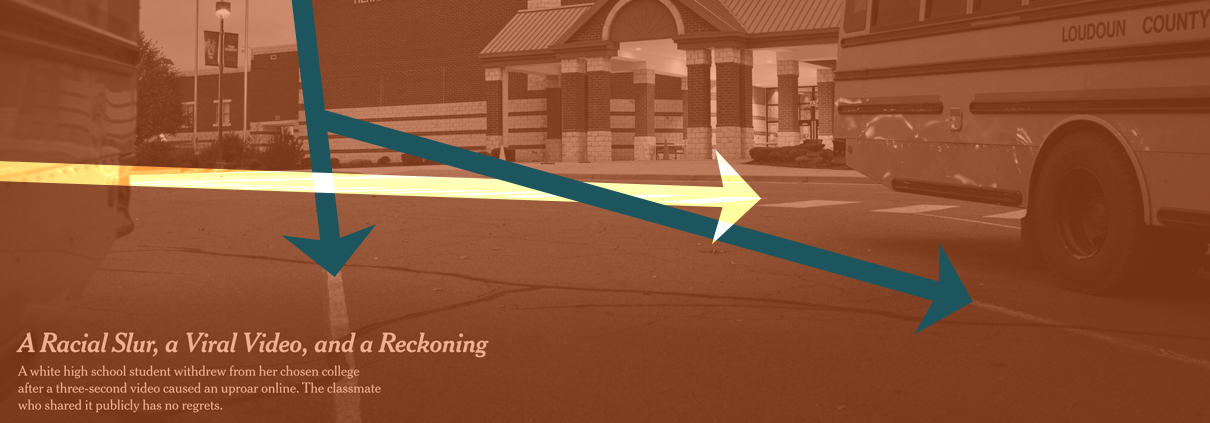Some Thoughts on “A Racial Slur, a Viral Video, and a Reckoning”
It was a trending story on nytimes.com, and for good reason.
Sitting in history class, Jimmy Galligan receives a message containing a very short video, just a few seconds long. The contents of the video: a classmate, Mimi Groves, saying “I can drive, [racial slur].” Not so incidentally, and as many would attest, it’s a racial slur that gets uttered far too often in the hallways of Loudoun County’s high schools. He’s biracial; she’s white.
He doesn’t confront her. Nor does he ignore it. Rather, he saves the video. He sits on it. Several years later, he posts it publicly. Uproar ensues. Mimi, by then a graduating senior, sees her admission to the University of Tennessee revoked. In response to the New York Times story, Jimmy, now a student at Vanguard University, faces vitriol himself. Some call him a “psychopath.”
The New York Times follows a policy of having a human moderate every single comment. They’re looking for relevancy. They’re looking for civility. They’re not looking for name-calling or personal attacks. Since commenting remains open only for a day or so for each Times story, the relatively few comments that make the cut end up holding some actual conceptual weight. In a way, they enter the historical record. This particular story received 1,622 public comments. We have some thoughts on them. A hundred years from now, two hundred years from now, four hundred years from now, folks might look back and say, “These are the things that readers of the New York Times thought about a story about race in America in the year 2020.”
Flashback to 1920
It’s the same way we can go to the New York Times “TimesMachine” and see what was happening in 1920.
There’s the story from January 23, 1920, about two long-standing members of the Board of Education in Camden, New Jersey. They resigned the day the mayor appointed a Black person to the Board.
There’s the story from July 4, 1920, called “Schools and the Negro.” The author says that the “tide of immigration northward” has made the “negro problem,” once exclusive to the South, a matter of “national importance.” The solution, argues the author: improve educational opportunities in the South so Black people stop moving to the North.
And then there’s the story from April 24, 1920, called “Negroes Attend High School Dance.” At issue: whether the Black students at a girls’ school in Brooklyn would be allowed to attend the school dance. Initially, the majority-white senior class voted to cancel the dance altogether rather than attend alongside their Black classmates.
The father of one of the Black girls complained to the superintendent, who referred the matter to a second superintendent, who reiterated that the dance could not take place unless there were no discrimination. At that point, the students reversed course and voted to hold the dance after all. These white girls, said the principal, “felt that the negro girls would have been delighted to have had the dance abandoned, so that they might say they had won.” One of the teachers reported that “everyone seems to be enjoying the dance” and that “the negro couples are keeping to themselves and not mingling with other students.”
By the way, the father who complained was a certain W. E. B. Dubois. His book Darkwater: Voices from within the Veil, would be published that same year. Among the first lines of the book: “I believe in the training of children, black even as white, the leading out of little souls into the green pastures and beside the still waters, not for pelf or peace, but for Life lit by some large vision of beauty and goodness and truth.” With those lines, Dubois was actually quoting himself, from a piece he had written sixteen years earlier. We all know he had been at this for a long time.
Back to the 2020 Comments
It would be hypothetical history to imagine what the comments section of any of those 1920 Times stories would’ve looked like. There wasn’t the near-instant gratification of anonymous posting back then. There wasn’t the fun veneer of social media covering up its undeniable horrors. There wasn’t social media at all. People’s mistakes haunted them in a different way back then. Still, though, you almost have to imagine that the hypothetical 1920 comments section wouldn’t look so different from 2020’s.
Most of the 1,622 comments posted in 2020 fall into one of two camps: anti-Mimi or anti-Jimmy. Both kids are wrong, they say, but here’s who I think is more wrong, and here’s why.
- “Ms. Groves and her family keep claiming that her life is ruined, but it’s not. She’s white and her family is well off. She will be fine.”
- “His actions, in contrast to hers, were intentionally cruel and calculating to inflict maximum damage. He is not a role model; he’s a bully, plain and simple.”
- “I don’t feel any pity for her whatsoever. At 15, in her learning and living environment, she knew darn well what this word meant, and why it shouldn’t be used.”
- “I guess I’m the only one bothered by the fact that Galligan purposely waited for years to release this video, with the express purpose of destroying her college chances. This goes far beyond wanting to ‘educate’ her—this is vindictive and chilling behavior.”
- “She perpetuated a hostile environment by using that word—she should pay the consequences. Yes, we’re all ‘cancellable’ to some extent—does that mean accountability shouldn’t be happening at all?”
- “I’m struck by the self righteousness of Mr. Galligan, now enrolled at a Christian school in California. Remind me—did Jesus have anything to say about mercy and forgiveness?”
The Times story as it’s written reduces the problem from systemic to individual. It prompts the reader to ask, “Should he have done this, and was this fair to her?” That prompting glosses over the underlying issues and the failure of the system to address those issues across the years. It avoids talking about the true impact of racism in schools. Racism in schools diminishes the learning of all students, including white students.
Strictly speaking, every single one of these commenters is valid. They’re being honest. They’re saying what they believe to be true. They’re representing their thoughts on the matter, based on their life’s experience up to the very point of clicking the “submit” button. There’s nothing wrong with that. However, there’s also nothing particularly right.
How will this story read in one hundred years? Maybe a mixture of shocking and utterly predictable. After all, how does the school dance story read now?
How will these comments read in one hundred years? Who knows?! But we’re thinking they might look like a collection of arguments written by stubborn individuals firmly entrenched in their ways—thoughtful, smart individuals willing to address important issues, sure, yet ultimately unwilling to budge, unwilling to listen, and unwilling to step back and think big.
We’re pro-budging. We’re pro-listening. And we’re pro-big-picture-thinking. There’s being on the right side of history, and then there’s actually trying your damnedest to do something. We’ve worked with Loudoun County Public Schools. That work—their work—is much more than this or any other individual story.



